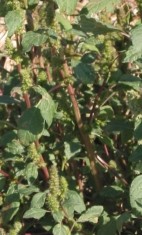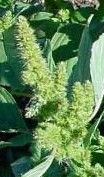 Redroot pigweed is a summer annual native to tropical America but grows throughout the United States including Alaska and Hawaii and is considered a noxious weed in some states. It prefers recently cultivated soil in full sun and is found in cropland, gardens, pastures, and roadsides. It can be high in nitrates and toxic to livestock but is said to be more attractive to some insects like flea beetles and blister beetles than garden plants and so its used as companion plants.
Redroot pigweed is a summer annual native to tropical America but grows throughout the United States including Alaska and Hawaii and is considered a noxious weed in some states. It prefers recently cultivated soil in full sun and is found in cropland, gardens, pastures, and roadsides. It can be high in nitrates and toxic to livestock but is said to be more attractive to some insects like flea beetles and blister beetles than garden plants and so its used as companion plants.
Description: Redroot pigweed makes its first appearance in mid-spring but continues to appear all summer especially following rain. It grows rapidly in warm weather and can reach almost 7 feet in height. The erect stems are branched, stout, sometimes  hairy, and may be purplish when young. The alternate leaves are oblong with pointed tips and have wavy margins and hair on the lower surface along the veins. They are borne on petioles ½” long. The small, green, inconspicuous flowers are produced in compact terminal racemes 2 to 8 inches in length and .75 inches wide. Smaller spikes of flowers may also be produced in the axils of the leaves. Each flower produces a tiny fruit with a single black shiny disc-shaped seed. The root system is a taproot and is sometimes reddish or pink.
hairy, and may be purplish when young. The alternate leaves are oblong with pointed tips and have wavy margins and hair on the lower surface along the veins. They are borne on petioles ½” long. The small, green, inconspicuous flowers are produced in compact terminal racemes 2 to 8 inches in length and .75 inches wide. Smaller spikes of flowers may also be produced in the axils of the leaves. Each flower produces a tiny fruit with a single black shiny disc-shaped seed. The root system is a taproot and is sometimes reddish or pink.

 Control: Since redroot pigweed is a prolific seed producer removing the plants before flowering is essential for control. Hand-pulling, tilling, or mowing are effective although several mowings may be necessary since redroot pigweed stems tend to resprout. Herbicides such as dicambra can be used for severe infestations.
Control: Since redroot pigweed is a prolific seed producer removing the plants before flowering is essential for control. Hand-pulling, tilling, or mowing are effective although several mowings may be necessary since redroot pigweed stems tend to resprout. Herbicides such as dicambra can be used for severe infestations.